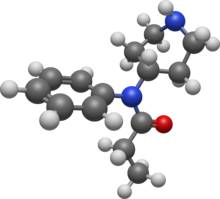Pharmaceutical compound
 | |
 | |
| Legal status | |
|---|---|
| Legal status |
|
| Identifiers | |
IUPAC name
| |
| CAS Number | |
| PubChem CID | |
| ChemSpider | |
| UNII | |
| ChEBI | |
| ChEMBL | |
| CompTox Dashboard (EPA) | |
| ECHA InfoCard | 100.015.040 |
| Chemical and physical data | |
| Formula | C14H20N2O |
| Molar mass | 232.327 g·mol |
| 3D model (JSmol) | |
SMILES
| |
InChI
| |
Norfentanyl is an inactive synthetic opioid analgesic drug precursor. It is an analog and metabolite of fentanyl with the removal of the phenethyl moiety (or functional group) from fentanyl chemical structure.
Occurrence and Applications
Norfentanyl occurs primarily as a metabolite of its parent drug, fentanyl. However, it can also be used to synthesize fentanyl itself.
See also
- 3-Methylbutyrfentanyl
- 4-Fluorobutyrfentanyl
- 4-Fluorofentanyl
- α-Methylfentanyl
- Acetylfentanyl
- Benzylfentanyl
- Furanylfentanyl
- Homofentanyl
- List of fentanyl analogues
References
- Anvisa (31 March 2023). "RDC Nº 784 - Listas de Substâncias Entorpecentes, Psicotrópicas, Precursoras e Outras sob Controle Especial" [Collegiate Board Resolution No. 784 - Lists of Narcotic, Psychotropic, Precursor, and Other Substances under Special Control] (in Brazilian Portuguese). Diário Oficial da União (published 4 April 2023). Archived from the original on 3 August 2023. Retrieved 15 August 2023.
- "Fentanyl". Elsevier.
- Sofalvi, Szabolcs (2017). "An LC–MS-MS method for the analysis of carfentanil, 3-methylfentanyl, 2-furanyl fentanyl, acetyl fentanyl, fentanyl and norfentanyl in postmortem and impaired-driving cases". Journal of Analytical Toxicology. 41 (6): 473–483. doi:10.1093/jat/bkx052. PMID 28830122.
- Bista, Sudeep R. (2014). "Development, validation and application of an HPLC–MS/MS method for the determination of fentanyl and nor-fentanyl in human plasma and saliva". Journal of Chromatography. B (960): 27-33.
- Huynh, N-H.; et al. (2005). "Determination of fentanyl in human plasma and fentanyl and norfentanyl in human urine using LC–MS/MS". Journal of Pharmaceutical and Biomedical Analysis. 37 (5): 1095–1100. doi:10.1016/j.jpba.2004.09.024. PMID 15862690.
- Poklis, Alphonse (2004). "Urine concentrations of fentanyl and norfentanyl during application of Duragesic® transdermal patches". Journal of Analytical Toxicology. 28 (6): 422–425. doi:10.1093/jat/28.6.422. PMID 15516290.
- Coopman, Vera (2007). "LC–MS/MS analysis of fentanyl and norfentanyl in a fatality due to application of multiple Durogesic® transdermal therapeutic systems". Forensic Science International. 169 (2–3): 223–227. doi:10.1016/j.forsciint.2006.03.018. PMID 16650707.
- Peer, Cody J. (2007). "Direct-injection mass spectrometric method for the rapid identification of fentanyl and norfentanyl in postmortem urine of six drug-overdose cases". Journal of Analytical Toxicology. 31 (8): 515–521. doi:10.1093/jat/31.8.515. PMID 17988466.
- Vandergrift, Gregory W. (2018). "Paper spray mass spectrometry for the direct, semi-quantitative measurement of fentanyl and norfentanyl in complex matrices". Clinical Biochemistry. 54: 106–111. doi:10.1016/j.clinbiochem.2018.02.005. PMID 29432758.
- Patton, Amy L. (2014). "Quantitative measurement of acetyl fentanyl and acetyl norfentanyl in human urine by LC-MS/MS". Analytical Chemistry. 86 (3): 1760–1766. doi:10.1021/ac4036197. PMID 24354295.
Further reading
- Higashikawa Y, Suzuki S (June 2008). "Studies on 1-(2-phenethyl)-4-(N-propionylanilino)piperidine (fentanyl) and its related compounds. VI. Structure-analgesic activity relationship for fentanyl, methyl-substituted fentanyls and other analogues". Forensic Toxicology. 26 (1): 1–5. doi:10.1007/s11419-007-0039-1. S2CID 22092512.
- Alburges ME, Hanson GR, Gibb JW, Sakashita CO, Rollins DE (1992). "Fentanyl receptor assay. II. Utilization of a radioreceptor assay for the analysis of fentanyl analogs in urine". J Anal Toxicol. 16 (1): 36–41. doi:10.1093/jat/16.1.36. PMID 1322477.
- Woods J, Medzihradsky F, Smith C, Winger G, Gmerek D (1988). "Evaluation of new compounds for opioid activity: 1987 annual report". NIDA Res. Monogr. 81: 543–90. PMID 3136388.
- Aceto M, Bowman E, Harris L, May E (1988). "Dependence studies of new compounds in the rhesus monkey, rat, and mouse, 1987". NIDA Res. Monogr. 81: 485–542. PMID 3136386.
- Brine GA, Boldt KG, Huang PT, Sawyer DK, Carroll FI (2009). "Carbon-13 nuclear magnetic resonance spectra of fentanyl analogs". Journal of Heterocyclic Chemistry. 26 (3): 677–686. doi:10.1002/jhet.5570260329.
| General anesthetics (N01A) | |||||||||||||||
|---|---|---|---|---|---|---|---|---|---|---|---|---|---|---|---|
| Inhalational | |||||||||||||||
| Injection |
| ||||||||||||||
| |||||||||||||||
| Opioid receptor modulators | |||||
|---|---|---|---|---|---|
| μ-opioid (MOR) |
| ||||
| δ-opioid (DOR) |
| ||||
| κ-opioid (KOR) |
| ||||
| Nociceptin (NOP) |
| ||||
| Others |
| ||||